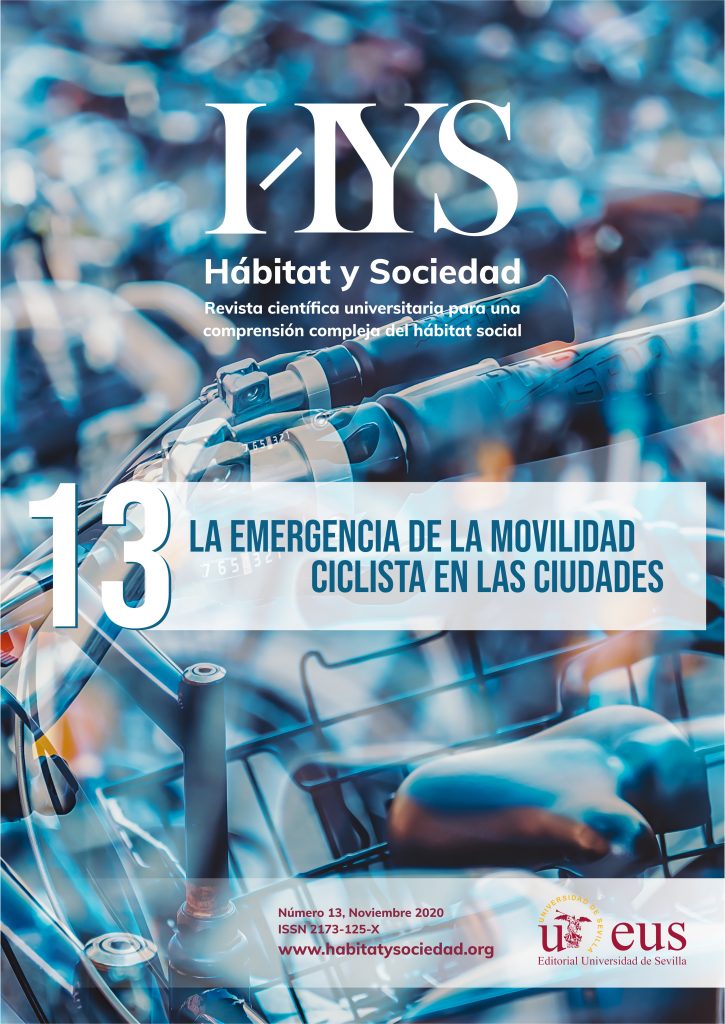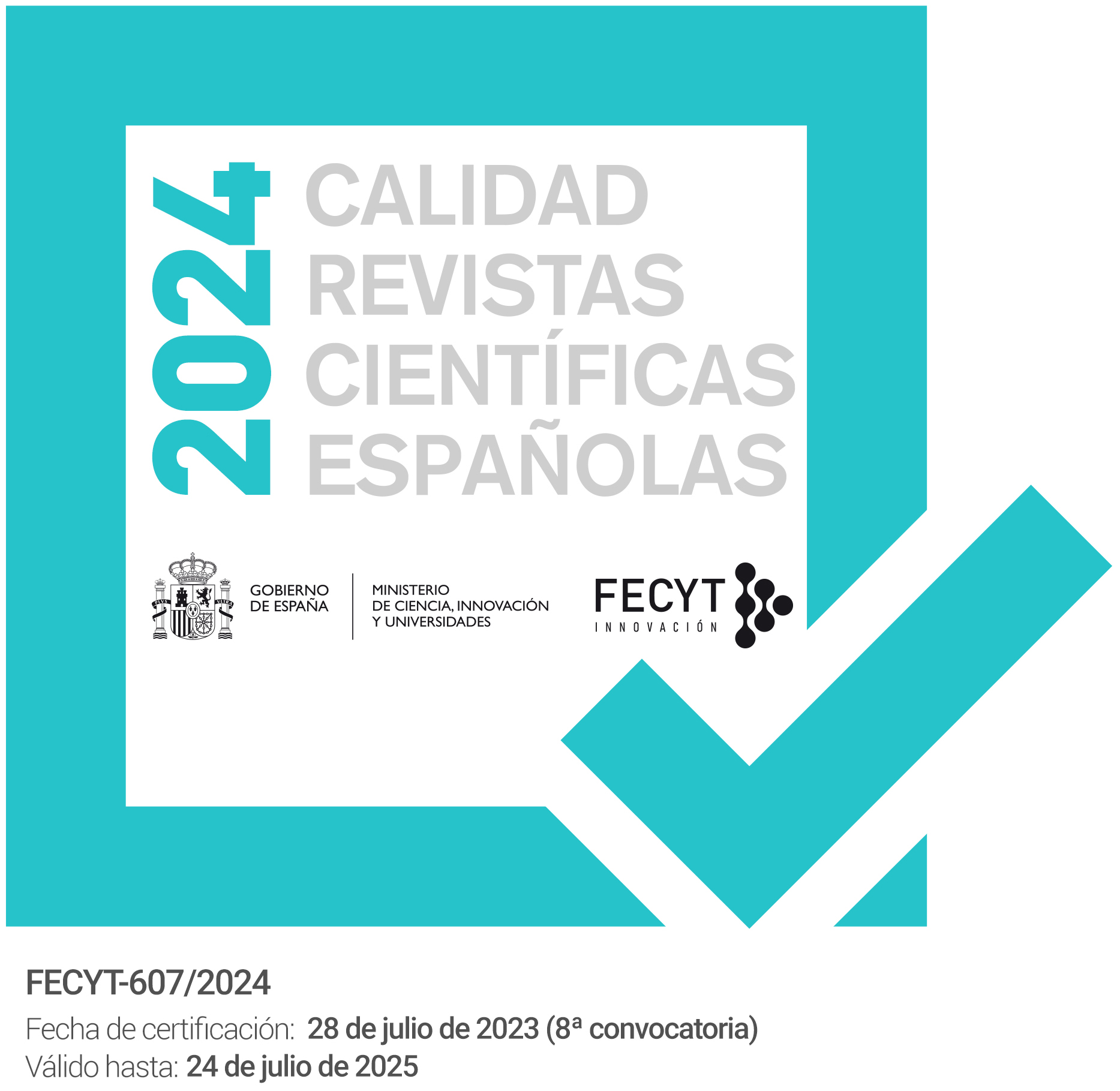The economic value for cycling – a methodological assessment for Starter Cities
DOI:
https://doi.org/10.12795/HabitatySociedad.2020.i13.03Palabras clave:
Value of Cycling, Cycling Impacts, Cycling Benefits, Economic Impacts.Resumen
The concerns about climate change, the effects of congestion and pollution in urban areas have led to the debate about the need for alternative mobility patterns in order to reduce the negative impacts of transport. At the same time, research on sustainable urban mobility highlights the value of cycling as a mean of transport and its economic, social and environmental benefits. Despite the proven benefits, investments in cycling are not always considered a priority, especially in contexts where cycling is residual, such as Portuguese cities, with an average modal share of 0.5%. In this context, the Boost project is developing a Starter Cities Roadmap to support planners and local authorities to promote bicycle use. This paper discusses Economic Value for Cycling (EVC) assessment model, developed to analyze the impacts of cycling or the promotion of cycling in the Portuguese economy, namely through the calculation of the bicycle industry value chain; economic impacts of reduced fuel consumption caused by modal shift; and the value of environmental, energy and health benefits at a local level.
Descargas
Citas
Adriano, P. (2012). O Direito , o Ambiente e a Mobilidade Sustentável : Aspetos Jurídicos da Mobilidade em Bicicleta. Coimbra.
Arsenio, E., & Ribeiro, P. (2015). The economic assessment of health benefits of active transport. Transport and Sustainability, 7, 1–22. https://doi.org/10.1108/S2044-994120150000007011
Banister, D. (2008). The sustainable mobility paradigm. Transport Policy, 15(2), 73–80. https://doi.org/10.1016/j.tranpol.2007.10.005
Blondel, B., Mispelon, C., & Ferguson, J. (2011). Cycle more oiften 2 cool down the Planet! European Cyclists’ Federation. Retrieved from http://www.ecf.com/wp-content/uploads/ECF_CO2_WEB.pdfnhttp://www.ecf.com/press_release/5056/
Blondiau T. and Zeebroeck B. (2014). Cycling works: Jobs and Job Creation in the Cycling Economy.
Blondiau, T., Van Zeebroeck, B., & Haubold, H. (2016). Economic Benefits of Increased Cycling. Transportation Research Procedia, 14, 2306–2313. https://doi.org/10.1016/j.trpro.2016.05.247
BYPAD. (2008). Cycling , the European approach -Total quality management in cycling policy. Results and lessons of the BYPAD-project.
Carvalho, J., D’Abreu, A. C., Pais, C., Gomes, P., Ferreira, A., Matos, A., … Madureira, R. (2013). Ocupação Dispersa: Custos e benefícios à escala local. Lisboa: Direção-Geral do Território.
Cox, P. (2019). Cycling: A Sociology of Vélomobility. London: Routledge.
Deenihan, G., & Caulfield, B. (2014). Estimating the health economic benefits of cycling. Journal of Transport & Health, 1(2), 141–149. https://doi.org/10.1016/J.JTH.2014.02.001
Deffner, J., Hefter, T., Rudolph, C., & Ziel, T. (2012). Handbook on cycling inclusive planning and promotion. Capacity development material for the multiplier training within the mobile2020 project. Frankfurt/Hamburg.
Delso, J., Martín, B., & Ortega, E. (2018). Potentially Replaceable Car Trips : Assessment of Potential Modal Change towards Active Transport Modes in Vitoria-Gasteiz. Sustainability, 10. https://doi.org/10.3390/su10103510
Demaio, P. (2009). Bike-sharing : History , Impacts , Models of Provision , and Future. Journal of Public Transportation, 12(4), 41–56.
Dill, J. (2009). Bicycling for Transportation and Health: The Role of Infrastructure. Journal of Public Health Policy, 30, S95–S110. https://doi.org/https://doi.org/10.1057/jphp.2008.56
Dill, J., & Carr, T. (2003). Bicycle Commuting and Facilities in Major U . S . Cities : If You Build Them , Commuters Will Use Them – Another Look. Transportation Research Record, 1828(1), 116–123.
ECF, & COLIBI-COLIPED. (2014). A Cycling Investment Plan for Europe.
European Commission. (2013a). A CONCEPT FOR SUSTAINABLE URBAN MOBILITY PLANS.
European Commission. (2013b). Together towards competitive and resource-efficient urban mobility.
European Cyclists’ Federation. (2017). EU Cycling Strategy - Recommendations for Delivering Green Growth and Effective Mobility System in 2030. EU Cycling Strategy. https://doi.org/10.1177/1060028017712725
Eurostat. (2018). Transport costs EU households over €1.1 trillion. Retrieved from https://ec.europa.eu/eurostat/web/products-eurostat-news/-/DDN-20200108-1?fbclid=IwAR0MYChsXRrPSv1eCJlGhHdekObReZDgq7AehU4mjfG3_zUfqSahZeiA3dY
Faghih-imani, A., Eluru, N., El-geneidy, A. M., Rabbat, M., & Haq, U. (2014). How land-use and urban form impact bicycle flows : evidence from the bicycle-sharing system ( BIXI ) in Montreal. Journal of Transport Geography, 41(August 2012), 306–314. https://doi.org/10.1016/j.jtrangeo.2014.01.013
Ferreira, J. P. (2016). How commuting influences urban economies and the environment: a commuting satellite account applied to the Lisbon Metropolitan Area. PhD Dissertation, University of Coimbra, Coimbra, Portugal.
Ferreira, J. P., Barata, E., Ramos, P. N., & Cruz, L. (2014). Economic, social, energy and environmental assessment of inter-municipality commuting: The case of Portugal. Energy Policy, 66, 411–418. https://doi.org/10.1016/j.enpol.2013.11.010
Ferreira, J. P., Ramos, P. N., Cruz, L., Barata, E., & Lahr, M. (2018). Port wine value chain: from the Douro Valley to Oporto Cellars. British Food Journal. https://doi.org/https://doi.org/10.1108/BFJ-03-2018-0162
Ferreira, J. P., Ramos, P. N., & Lahr, M. L. (2019). The rise of the sharing economy : Guesthouse boom and the crowding-out effects of tourism in Lisbon. Tourism Economics. https://doi.org/10.1177/1354816619839849
Fishman, E., Washington, S., & Haworth, N. (2014). Bike share ’ s impact on car use : Evidence from the United States , Great Britain , and Australia. TRANSPORTATION RESEARCH PART D, 31, 13–20. https://doi.org/10.1016/j.trd.2014.05.013
Flusche, B. D. (2012). Bicycling Means Business : The Economic Benefits of Bicycle Infrastructure.
Garrard, J., Rissel, C., & Bauman, A. (2012). Health benefits of cycling. City Cycling, 31.
Geus, B. De, & Hendriksen, I. (2015). Cycling for Transport, Physical Activity and Health: What about Pedelecs? Cycling Futures. From Research into Practice, (February), 17–32.
Goetzke, F. (2011). Bicycle Use in Germany : Explaining Differences between Municipalities with Social Network Effects. Uban Studies, (November 2014). https://doi.org/10.1177/0042098009360681
Gössling, S., Choi, A., Dekker, K., & Metzler, D. (2019). The Social Cost of Automobility , Cycling and Walking in the European Union. Ecological Economics, 158(December 2018), 65–74. https://doi.org/10.1016/j.ecolecon.2018.12.016
Gössling, S., & S. Choi, A. (2015). Transport transitions in Copenhagen: Comparing the cost of cars and bicycles. Ecological Economics, 106–113. https://doi.org/10.1016/j.ecolecon.2015.03.006.
Gylling, M., Heikkilä, J., Jussila, K., & Saarinen, M. (2015). Making decisions on offshore outsourcing and backshoring : A case study in the bicycle industry. Intern. Journal of Production Economics, 162, 92–100. https://doi.org/10.1016/j.ijpe.2015.01.006
Hamilton, T. L., & Wichman, C. J. (2018). Bicycle infrastructure and traffic congestion : Evidence from DC ’ s Capital Bikeshare. Journal of Environmental Economics and Management, 87, 72–93. https://doi.org/10.1016/j.jeem.2017.03.007
Haubold, H. (2016). Shopping by bike: Best friend of your city centre. Retrieved from https://ecf.com/sites/ecf.com/files/CYCLE N LOCAL ECONOMIES_internet.pdf
Held, M., Schindler, J., & Litman. (2016). Cycling and Active Mobility - Establishing a Third Pillar of Transport Policy. In R. Gerike & J. Parkin (Eds.), Cycling Futures: From Research into Practice. Routledge.
Hendriksen, I. J. M., Simons, M., Garre, F. G., & Hildebrandt, V. H. (2010). The association between commuter cycling and sickness absence. Preventive Medicine, 51(2), 132–135. https://doi.org/10.1016/j.ypmed.2010.05.007
Humphrey, J. (2003). Globalization and supply chain networks : the auto industry in Brazil and India. Global Networks 3, 2, 121–141.
INE. (2011). Censos.
INE. (2012). Portuguese National Accounts.
INE. (2018). Mobilidade e funcionalidade do território nas Áreas Metropolitanas do Porto e de Lisboa, 2017.
Krizec, K. J. (2007). Estimating the economic benefits of bicycling and bicycle facilities: An interpretive review and proposed methods. In P. Coto-Millán & V. Inglada (Eds.), Essays on Transport Economics.
Lindsay, G., Macmillan, A., & Woodward, A. (2011). Moving urban trips from cars to bicycles: impact on health and emissions. Australian and New Zeland Journal of Public Health, 35(1), 54–60. https://doi.org/10.1111/j.1753-6405.2010.00621.x
Litman, T. (2019). Evaluating Active Transport Benefits and Costs.
Macmillan, A., Connor, J., Witten, K., Kearns, R., Rees, D., & Woodward, A. (2013). The Societal Costs and Benefits of Commuter Bicycling : Simulating the Effects of Specific Policies Using System Dynamics Modelling, 122(4), 1–26. https://doi.org/10.1289/ehp.1307250
Marqués, R., Hernández-Herrador, V., & Calvo-Salazar, M. (2014). Sevilla: A Successful Experience Of Bicycle Promotion In A Mediterranean Context. WIT Transactions on Ecology and the Environment, 191, 769–781. https://doi.org/10.2495/SC140651
Mason, J., Fulton, L., & Mcdonald, Z. (2015). A Global High Shift Cycling Scenario.
Médard de Chardon, C. (2016). A Geographical Analysis of Bicycle Sharing Systems. Doctoral thesis, University of Luxembourg and Université catholique de Louvain.
MINISTÉRIO DO AMBIENTE. (2018). PORTUGAL CICLÁVEL 2030.
Mota, J. C. B. (2015). Apresentação: CIDADES E REGIÕES BIKE-FRIENDLY DE SEGUNDA GERAÇÃO, DESAFIOS DO PERÍODO DE PROGRAMAÇÃO 2014-2020.
Moura e Sá, F. (2015). A INFRAESTRUTURA COMO REFERENCIAL PARA O ORDENAMENTO DO TERRITÓRIO.
Moura e Sá, F. (2017). Apresentação: A integração da bicicleta em meio urbano principais desafios e orientações.
Neun, M., & Haubold, H. (2016). THE EU CYCLING ECONOMY - Arguments for an integrated EU cycling policy. Brussels.
Parkin, J., Wardman, Æ. M., & Page, Æ. M. (2008). Estimation of the determinants of bicycle mode share for the journey to work using census data, 93–109. https://doi.org/10.1007/s11116-007-9137-5
Piket, P., Eijgelaar, E., & Peeters, P. (2013). European cycle tourism: a tool for sustainable regional rural development. Applied Studies In Agribusiness And Commerce, 7(2-3), 115–119. https://doi.org/10.19041/Apstract/2013/2-3/19
Raje, F., & Saffrey, A. (2008). The Value of Cycling. Phil Jones Associates, & University of Birmingham. https://doi.org/10.1002/bjs.9465.
Randall, T., & Ulrich, K. (2001). Product Variety , Supply Chain Structure , and Firm Performance : Analysis of the U.S. Bicycle Industry. Management Science, 47, 1588–1604.
Ricci, M. (2015). Bike Sharing: a review of evidence on impacts and processes of implementation and operation. Research in Transportation Business & Management, 15. https://doi.org/10.1016/j.rtbm.2015.03.003
Rojas-rueda, D., Nazelle, A. De, & Tainio, M. (2011). The health risks and benefits of cycling in urban environments compared with car use : health impact assessment study, 1–8. https://doi.org/10.1136/bmj.d4521
Rupprecht Consult. (2019). Guidelines For Developing and Implementing a Sustainable Urban Mobility Plan, Second Edition.
Rutter, H., Cavill, N., Racioppi, F., Dinsdale, H., Oja, P., & Kahlmeier, S. (2013). Economic impact of reduced mortality due to increased cycling. American Journal of Preventive Medicine, 44(1), 89–92. https://doi.org/10.1016/j.amepre.2012.09.053
Saelens, B. E., Frank, L. D., & Med, A. B. (2003). Environmental correlates of Walking and Cycling : Findings From the Transportation , Urban Design , and Planning Literatures Environmental Correlates of Walking and Cycling : Findings From the Transportation , Urban Design , and Planning Literatures. Annals of Behavioral Medicine, 25 (2). https://doi.org/10.1207/S15324796ABM2502
Silva, C., Teixeira, J., Proença, A., Bicalho, T., Cunha, I., & Aguiar, A. (2019). Revealing the cycling potential of starter cycling cities : Usefulness for planning practice. Transport Policy, 81(August 2018), 138–147. https://doi.org/10.1016/j.tranpol.2019.05.011
Steenberghen, T., Tavares, T., Richardson, J., Himpe, W., & Crabbé, A. (2017). Support study on data collection and analysis of active modes use and infrastructure in Europe.
Sustrans. (2019). Bike Life - The potential of everyday cycling.
Teschke, K., Reynolds, C. C. O., Ries, F. J., Gouge, B., & Winters, M. (2012). Bicycling: Health Risk or Benefit? The University of British Columbia Medical Journal, 3(March), 6–11. https://doi.org/10.1177/1475921718760483
Titze, S., Geus, B. De, Brussel, V. U., & Krenn, P. (2011). Health benefits of cycling : A systematic review Health benefits of cycling : a systematic review. Scandinavian Journal of Medicine & Science in Sports, (July 2018). https://doi.org/10.1111/j.1600-0838.2011.01299.x
Tiwari, G., Arora, A., & Jain, H. (2008). Bicycling in Asia.
Tolley, R. (1996). Green campuses : cutting the environmental cost of commuting. Journal of Transport Geography, 4(3), 213–217.
Towill, D., & Christopher, M. (2010). The Supply Chain Strategy Conundrum : To be Lean Or Agile or To be Lean And Agile ? The Supply Chain Strategy Conundrum : To be Lean Or Agile or To be Lean And Agile ?*. International Journal of Logistics, 5(3), 299–309. https://doi.org/10.1080/1367556021000026736
Tzeng, G., Tang, T., Hung, Y., & Chang, M. (2006). Multiple-objective planning for a production and distribution model of the supply chain: Case of a bicycle manufacturer. Journal of Scientific & Industrial Research, 65(April), 309–320.
Vergnani, R. (2019). Cycle paths and bike sharing: new funds from the Italian Ministry for the Environment. Retrieved from https://www.eltis.org/discover/news/cycle-paths-and-bike-sharing-new-funds-italian-ministry-environment?platform=hootsuite
Weston, R., Davies, N., Lumsdon, L., McGrath, P., Peeters, P., Eijgelaar, E., & Piket, P. (2012). The European Cycle Route Network EuroVelo - Challenges and Opportunities for Sustainable Tourism.
Weston, R., & Mota, J. C. (2012). Low Carbon Tourism Travel: Cycling, Walking and Trails. Tourism Planning and Development, 9(1), 1–3. https://doi.org/10.1080/21568316.2012.658168
WHO. (2009). Global health risks: mortality and burden of disease attributable to selected major risks.
WHO. (2011). Health economic assessment tools ( HEAT ) for walking and for cycling: Methodology and user guide.
World Healt Organization (WHO). (2002). A Physically Active Life Through Everyday Transport. Regional Office for Europe.
Zayed, M. A. (2017). International Journal of Transportation Towards an index of city readiness for cycling. International Journal of Transportation Science and Technology, 5(3), 210–225. https://doi.org/10.1016/j.ijtst.2017.01.002
Zeebroeck, B. Van, & Charles, J. (2014). Impact et potentiel de l ’ usage du vélo sur l ’ économie et l ’ emploi en Région de Contenu.
Zhang, Y., & Mi, Z. (2018). Environmental bene fi ts of bike sharing : A big data-based analysis, 220(March), 296–301. https://doi.org/10.1016/j.apenergy.2018.03.101
Descargas
Publicado
Cómo citar
Número
Sección
Licencia
Derechos de autor 2020 De los autores y Editorial Universidad de Sevilla

Esta obra está bajo una licencia internacional Creative Commons Atribución-NoComercial-CompartirIgual 4.0.
Los textos publicados se considerarán propiedad intelectual de los autores y de la revista. Podrán ser usados para usos educativos y académicos, citando al autor y la publicación, con la dirección electrónica exacta. En todo caso, deberá comunicarse este tipo de uso y pedir la autorización del mismo a la dirección de la revista.
Los autores/as que publiquen en esta revista aceptan las siguientes condiciones:
- Los autores/as conservan los derechos de autor y ceden a la revista el derecho de la primera publicación, con el trabajo registrado con la licencia de atribución de Creative Commons, que permite a terceros utilizar lo publicado siempre que mencionen la autoría del trabajo y la primera publicación en esta revista.
- Los autores/as pueden realizar otros acuerdos contractuales independientes y adicionales para la distribución no exclusiva de la versión del artículo publicado en esta revista (p. ej., incluirlo en un repositorio institucional o publicarlo en un libro) siempre que indiquen claramente que el trabajo se publicó por primera vez en esta revista.
- Se permite y recomienda a los autores/as publicar su trabajo en Internet (por ejemplo en páginas institucionales o personales) antes y durante el proceso de revisión y publicación, ya que puede conducir a intercambios productivos y a una mayor y más rápida difusión del trabajo publicado (véase The Effect of Open Access).













